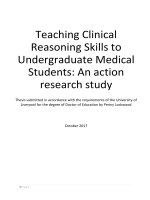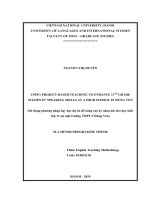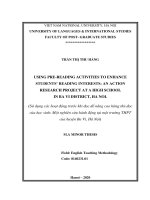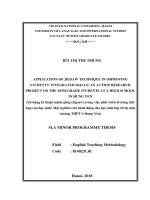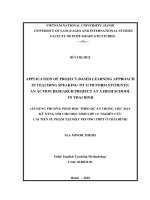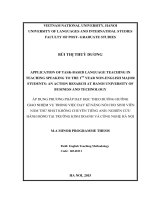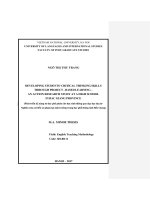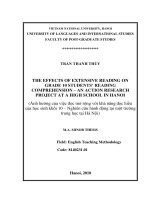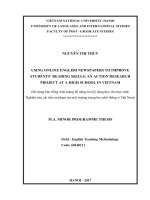Application of project based learning approach in teaching speaking to 11th form students an action research project at a high school in thai binh
Bạn đang xem bản rút gọn của tài liệu. Xem và tải ngay bản đầy đủ của tài liệu tại đây (2.68 MB, 123 trang )
VIETNAM NATIONAL UNIVERSITY, HANOI
UNIVERSITY OF LANGUAGES AND INTERNATIONAL STUDIES
FACULTY OF POST-GRADUATE STUDIES
---oOo---
BÙI THỊ HUỆ
APPLICATION OF PROJECT-BASED LEARNING APPROACH
IN TEACHING SPEAKING TO 11TH FORM STUDENTS:
AN ACTION RESEARCH PROJECT AT A HIGH SCHOOL
IN THAI BINH
(ÁP DỤNG PHƢƠNG PHÁP HỌC THEO DỰ ÁN TRONG VIỆC DẠY
KỸ NĂNG NÓI CHO HỌC SINH LỚP 11: NGHIÊN CỨU
CẢI TIẾN SƢ PHẠM TẠI MỘT TRƢỜNG THPT Ở THÁI BÌNH)
M.A MINOR THESIS
Field: English Teaching Methodology
Code: 8140231.01
Hanoi - 2018
VIETNAM NATIONAL UNIVERSITY, HANOI
UNIVERSITY OF LANGUAGES AND INTERNATIONAL STUDIES
FACULTY OF POST-GRADUATE STUDIES
---oOo---
BÙI THỊ HUỆ
APPLICATION OF PROJECT-BASED LEARNING APPROACH
IN TEACHING SPEAKING TO 11TH FORM STUDENTS:
AN ACTION RESEARCH PROJECT AT A HIGH SCHOOL
IN THAI BINH
(ÁP DỤNG PHƢƠNG PHÁP HỌC THEO DỰ ÁN TRONG VIỆC DẠY
KỸ NĂNG NÓI CHO HỌC SINH LỚP 11: NGHIÊN CỨU
CẢI TIẾN SƢ PHẠM TẠI MỘT TRƢỜNG THPT Ở THÁI BÌNH)
M.A MINOR THESIS
Field: English Teaching Methodology
Code: 8140231.01
Supervisor: Dr. Nguyễn Thị Hƣơng
Hanoi - 2018
DECLARATION
I certify that no part of the thesis entitled “Application of Project-Based Learning
Approach in teaching speaking to 11th form students: An action research project at
a High School in Thai Binh.” has been copied or reproduced by me from any other
works without acknowledgement and that the thesis is originally written by me
under strict guidance of my supervisor.
Hanoi, 2018
Student‘s signature
Bùi Thị Huệ
1
ACKNOWLEGEMENTS
First of all, I would like to express my heartfelt gratitude to my supervisor,
Dr. Nguyen Thi Huong for her enthusiastic support, helpful guidance and
considerable encouragement. Without her instruction, I could not complete the
study.
Secondly, I would also like to thank my beloved students for their
enthusiastic participation in the PBL lessons, the questionnaire as well as the
interviews. Without their passionate participation, the study could not have been
successfully implemented.
Also, I want to send my sincere thanks to the headmaster of Dong Thuy Anh
High School for permitting me to carry out the study in our school. In addition, I am
grateful to my colleagues who helped me in implementing the study in the school.
Finally, I must express my very profound gratitude to my husband and my
family for their support and encouragement. Without their help, I could not
complete my master program or implement the study.
2
ABSTRACT
This study is carried out to examine how Project-Based Learning affects
students‘ speaking skills as well as students‘ opinions on Project-Based Learning
implementation. The study adopts action research with the use of both quantitative
and qualitative data collection methods, including pre- and post – tests,
questionnaire, teaching journals and interviews. The findings report that the
students in the study made some significant improvement in their speaking scores.
More specifically, the average-level students are likely to benefit the most from this
activity because their speaking scores are raisen the most. In term of the speaking
test criteria including grammar and vocabulary, pronunciation, discourse
management and interactive communication, the students also made a lot of
progress. However, each level group of students did not make improvement
equally; even there is a group which did not make any progress. Apart from that, the
results from the interviews and questionnaire with the students as well as the
teaching journals reveal that a majority of students are in favor of PBL. Despite the
positive outcome of the research, there is still a need for further studies to assess
more PBL‘s effects and the best way to apply PBL in official school curricula.
3
TABLE OF CONTENTS
DECLARATION .......................................................................................................1
ACKNOWLEGEMENTS.........................................................................................2
ABSTRACT ...............................................................................................................3
TABLE OF CONTENTS ..........................................................................................4
LIST OF FIGURES ..................................................................................................7
CHAPTER 1: INTRODUCTION ............................................................................8
1.1 Rationale of the study ......................................................................................8
1.2. Aims and objectives of the study ...................................................................9
1.3. Significance of the study .................................................................................9
1.4. Methods of the study.....................................................................................10
1.5. Structure of the study ...................................................................................10
CHAPTER 2: LITERATURE REVIEW ..............................................................12
2.1. Speaking in foreign language learning .......................................................12
2.1.1. Definition of speaking ..............................................................................12
2.1.2. Speaking skills ..........................................................................................12
2.1.3. Principles of speaking teaching ................................................................13
2.2. Project-Based Learning ................................................................................13
2.2.1. Definition of Project-Based Learning ......................................................13
2.2.2. Characteristics of Project-Based Learning ...............................................15
2.2.3. Benefits of Project-Based Learning .........................................................16
2.2.4. Theoretical framework: PBL approach to teaching speaking ..................17
2.3. Related studies...............................................................................................19
CHAPTER 3: RESEARCH METHODOLOGY ................................................21
3.1. Research methodology ..................................................................................21
3.2. Setting of the study .......................................................................................23
3.3. Participants ....................................................................................................23
3.4. Research design .............................................................................................23
3.5. Data collection procedure ............................................................................24
4
3.6. Data analysis ..................................................................................................27
CHAPTER 4: FINDINGS AND DISCUSSIONS .................................................29
4.1. Research question 1 ......................................................................................29
4.1.1. Classification of the students‘ levels based on the pretest results ............29
4.1.2. Effects of PBL on the students‘ overall speaking skills ...........................30
4.1.3. Effects of PBL on the students‘ grammar and vocabulary ......................33
4.1.4. Effects of PBL on the students‘ discourse management ..........................35
4.1.5. Effects of PBL on the student‘s pronunciation ........................................38
4.1.6. Effects of PBL on the students‘ interactive communication ....................39
4.2. Research question 2 ......................................................................................41
4.2.1. Students‘ opinions on PBL .......................................................................42
4.2.2. Student‘s perception of the PBL speaking lessons...................................44
4.2.2.1. Lesson topics................................................................................................ 45
4.2.2.2. Teacher‘s instruction.................................................................................... 48
4.2.2.3. Learning activities........................................................................................ 50
4.2.2.4. Language resources...................................................................................... 53
4.2.3. Conclusion ................................................................................................54
CHAPTER 5: CONCLUSION ...............................................................................56
5.1. Major findings of the study ..........................................................................56
5.1.1. The effects of PBL on students‘ speaking skills ......................................56
5.1.2. Students‘ opinions on PBL implementation in class ................................57
5.2. Reflection .......................................................................................................58
5.3. Pedagogical suggestions ...............................................................................60
5.4. Suggestions for further studies ....................................................................60
5.5. Limitations of the study ................................................................................61
REFERENCES .......................................................................................................... I
APPENDICES ........................................................................................................ IV
APENDIX A: PRE AND POST SPEAKING TEST ....................................... IV
1. PRE-SPEAKING TEST ................................................................................ IV
2. POST SPEAKING TEST ................................................................................ V
5
3. SPEAKING TEST CRITERIA .................................................................... VII
APENDIX B: LESSON PLANS .................................................................... VIII
1. PROJECT 1 ................................................................................................. VIII
2. PROJECT 2 ............................................................................................... XXII
3. PROJECT 3 ............................................................................................ XXXII
APENDIX C: QUESTIONNAIRE .......................................................... XLVIII
APENDIX D: INTERVIEWS ............................................................................ LI
6
LIST OF FIGURES
Figure 1: The number of students in each group arranged by their pretest speaking scores29
Figure 2: Mean comparison of overal pretest and posttest scores ....................................... 30
Figure 3: Students' perception on their speaking skill improvement after PBL lessons...... 31
Figure 4: Students' perception on PBL's boosting their confidence .................................... 32
Figure 5: Mean comparison of grammar and vocabulary scores of the pretest and posttest
............................................................................................................................................. 34
Figure 6: Students' perception on their improvement in grammar and vocabulary after PBL
lessons .................................................................................................................................. 34
Figure 7: Mean comparison of discourse management scores of the pretest and posttest .. 36
Figure 8: Students' perceptions on their fluency and coherence improvements after PBL
lessons .................................................................................................................................. 37
Figure 9: Mean comparison of pronunciation scores of the pretest and posttest ................. 38
Figure 10: Students' perception on their pronunciation improvements after PBL lessons .. 38
Figure 11:Mean comparison of interactive communication scores of the pretest and posttest
............................................................................................................................................. 40
Figure 12: Students' opinions on their improvement in interactive communication after
PBL lessons.......................................................................................................................... 40
Figure 13: Students' opinions on their involvement in PBL class ....................................... 42
Figure 14: Students' opinions on the unncessity of PBL in English speaking classroom ... 43
Figure 14: Students' opinions on carrying out more PBL activities in the future................ 44
Figure 15: Students' opinions on the appropriateness of PBL in English speaking classroom
............................................................................................................................................. 44
Figure 16: Students' opinions on the appropriateness of the project topics ......................... 45
Figure 17: Students' opinions on the appropriateness of the teacher's instruction .............. 49
Figure 18: Students' opinions on the appropriateness of time allocation for each project .. 50
Figure 19: Students' opinions on the stimulation and engagement of PBL in comparison
with other speaking activities .............................................................................................. 51
7
CHAPTER 1: INTRODUCTION
In this chapter, the rationale, aims and objectives, significance of the study
are presented. Also, the research questions, chosen research methods and structure
of the researcher are put forward.
1.1 Rationale of the study
The need for acquiring good communicative skills in English has been
increasing in everyday and work situations. So speaking has played an increasingly
essential role in second language learning settings. It is also the reason why Dong
Thuy Anh High School, a prestigious state high school in Thai Binh province, has
been paying more attention in teaching speaking skills for students recently.
However, being orally competent in English has still been a far-fetched dream
among most of students.
In the researcher‘s real teaching context, it is noticed that the majority of the
researcher‘s students really want or need to be fluent in speaking English. In spite of
their desires, many of them cannot perform the speaking tasks successfully.
Surprisingly, they actually have good ideas since they can express their opinions
cogently on the papers but when being asked to speak, they become nerve-racking,
hesistant and disorganized. Some even do not feel elated and enthusiastic when
participating in oral activities and tend to work independently in pair or group work.
This is due to such possible reasons as tension, shyness and/ or lack of confidence,
and effective communication skills in English. Besides, the teaching strategies used,
the uninteresting activities in the text book or lack of opportunities to communicate
orally also make students stay passive in speaking lessons.
This problem urges the researcher to find suitable methods in order to help
students take part in communicative tasks actively and gregariously. The researcher
thinks that authentic learning experience can be a solution. Bringing the real world
problems into the classroom can encourage students‘ engagement, curiosity,
inquiry, which could motivate them to participate actively in speaking lessons.
Project-Based Learning (PBL), which has been strongly promoted in recent years,
8
meets the above requirements because according to George Lucas Educational
Foundation (2001), through PBL, students explore real-world problems and
challenges, simultaneously developing cross-curriculum skills while working in
small collaborative groups.
Considering the benefits of PBL that can bring to the students, the researcher
conducts a study on the implementation of PBL to develop the English speaking
skill for eleventh - grade students at Dong Thuy Anh High School.
1.2. Aims and objectives of the study
To begin with, the study is carried out in Dong Thuy Anh High School in
order to find out whether PBL activities can help the 11th form students improve
their speaking skills or not. Their speaking competence development is measured
via two tests: one before PBL and the other after PBL. Afterward, the paper
investigates the students‘ attitude on the use of PBL in the class in term of the
effectiveness of PBL, their perceptions on PBL implementation in the class and so
on.
In short, the objectives of the study could be summarized into two research
questions as follows:
1. To what extent does the Project- Based Learning help to improve speaking
skill for grade 11 students at Dong Thuy Anh High School?
2. What are the students‘ opinions on the PBL in learning speaking?
1.3. Significance of the study
Once the study is completed, it will serve as one of the first to investigate the
use of PBL in Dong Thuy Anh High School. Thus, it may be of considerable use for
other teachers of English in Dong Thuy Anh High School or researchers who want
to investigate more in applying PBL to high school students.
Furthermore, the study is an action research, i.e. PBL is applied on the class
the researcher is teaching. This helps to enhance the validity of the feasibility of
PBL in schools. So, the recommendations and conclusions from the study could be
9
useful to the policymakers in Dong Thuy Anh High School as well as in other
schools nationwide if PBL is consider to be applied into school curricula.
1.4. Methods of the study
The study uses the approach of an action research, i.e. PBL would be applied
directly into the class that the researcher is teaching. Also, both qualitative and
quantitative data collection and analysis methods are applied into this research. In
term of qualitative method, interviews are used to gather student‘s opinions toward
PBL activities in class. In term of quantitative method, questionnaires and tests are
applied. The results from the questionnaire and interviews will be regarded to the
students‘ general attitude toward PBL, their perception on the effectiveness of PBL
on their speaking levels and speaking skills. Means of pretest and posttest scores
would be calculated to determine the effects of PBL on the students‘ speaking
scores. Both the methods are cooperative to each other. The results from the
speaking scores would be compared with the data collected in the interviews and
questionnaire.
1.5. Structure of the study
The paper consists of five chapters as follows:
Chapter 1 serves as the general guideline for the whole paper. The rationale, aims
and objectives, significance and methods of the study are presented clearly.
Chapter 2 provides the theoretical base for the study. Specifically, key terms
such as speaking and PBL are adequately explained. Also, the related studies are
also discussed.
Chapter 3 illustrates the methodology to carry out the study. Also, the
participants and instrument of data collection are mentioned. The choice of
participants and data collection methods is justified in this chapter. Furthermore, the
procedure to carry out the research is mentioned.
10
Chapter 4 discusses the findings from the pretest and posttest, questionnaire and
interviews. These data are analysed thoroughly to answer the research questions.
Chapter 5 summarizes the findings of the study and the suggestions for other
researchers, colleagues and policymakers. Besides, the limitations of the study are
discussed.
The last parts are Appendices and Bibliography.
11
CHAPTER 2: LITERATURE REVIEW
In this chapter, all the key concepts such as “speaking anxiety” and “causes
of speaking anxiety” are defined as the frame for the study. Also, a brief overview
of the related studies discloses the research gap and justifies the aims and
objectives of this research paper.
2.1. Speaking in foreign language learning
2.1.1. Definition of speaking
Nunan (1999:216) states
that speaking is an interactive process
of
constructing meaning that involves producing, receiving and processing information.
Its form and meaning are depending on the context in which it occurs, including the
participants themselves, their experiences, the physical environment, and the
purposes for speaking. It is often spontaneous, open-ended, and evolving. However,
speech is not always unpredictable. Speaking requires that learners not only know
how to produce specific points of language such as grammar, pronunciation or
vocabulary (―linguistic competence‖) but also that they understand when, why, and
what ways to produce language (―sociolinguistic competence‖)
2.1.2. Speaking skills
Nunan (2003:3) defines teaching speaking skills is to teach learners to: (1)
produce the English speech sounds and sound patterns; (2) use word and sentence
stress, intonation patterns and the rhythm of the second language; (3) select
appropriate words and sentences according to the proper social setting, audience,
situation and subject matter; (4) organize their thoughts in a meaningful and logical
sequence; (5) use language as a means of expressing values and judgments; (6) use
the language quickly and confidently with few unnatural pauses, which is called as
fluency.
Today's world requires that the goal of teaching speaking should improve
students' communicative skills, because, only in that way, students can express
12
themselves and learn how to follow the social and cultural rules appropriate in each
communicative circumstance. Burkart ( 1998:13) states that the goal of teaching
spoken language for communication is to enable students to produce spoken
messages as they carry out a range of tasks in a variety of contexts outside
classroom. They should be able to use the language to interpret, express and
negotiate meaning.
In brief, to achieve the goal of teaching speaking, EFL teachers should create
a classroom environment where students have real-life communication, authentic
activities and meaningful tasks that promote oral language.
2.1.3. Principles of speaking teaching
To make students able to communicate in the target language, the English
teacher should be aware of implementing classroom-speaking process that is rested
on the underlying principles suggested by Brown ( 2007) :
1. Provide intrinsically motivating techniques
2. Encourage the use of authentic language in meaningful contexts
3. Provide appropriate feedback and correction
4. Capitalize on the natural link between speaking and listening
5. Give students opportunities to initiate oral communication
6. Encourage the development of speaking strategies
2.2. Project-Based Learning
2.2.1. Definition of Project-Based Learning
Like other scientific concepts that raise many researchers‘ interest, ProjectBased Learning has a variety of definitions. Each definition is the reflection of the
underlying theories or perspectives that the authors assume.
13
Project-Based Learning hails from a tradition of pedagogy which asserts that
students learn best by experiencing and solving real-world problems. According to
researchers (Barron & Darling-Hammond, 2008; Thomas, 2000), Project-Based
Learning essentially involves the following:
students learning knowledge to tackle realistic problems as they would be
solved in the real world
increased student control over his or her learning
teachers serving as coaches and facilitators of inquiry and reflection
students (usually, but not always) working in pairs or groups
John Thomas (2000) explains that project-based learning requires ―complex
tasks, based on challenging questions or problems, that involve students in design,
problem-solving, decision making, or investigative activities; give students the
opportunity to work relatively autonomously over extended periods of time; and
culminate in realistic products or presentations.‖
Another view of Project-Based Learning is from The Buck Institute for
Education (BIE) (2012). Project-Based Learning is defined as ―a systematic
teaching method that engages students in learning knowledge and skills through an
extended inquiry process structured around complex, authentic questions and
carefully designed products and tasks.‖ This process can last for varying time
periods and can extend over multiple content areas.
Furthermore, Patton (2012:13) remarks that Project- Based Learning refers
to a methods allowing students to design, plan, and carry out an extended project
that produces a publicly exhibited output such as a product, publication or
presentation. Through PBL, the learners are engaged in purposeful communication
to complete authentic activities (project-work), so that they have the opportunity to
use the language in a relatively natural context (Haines, 1989, as cited in Fragoulis,
14
2009) and participate in meaningful activities which require authentic language use
(Fragoulis, 2009).
2.2.2. Characteristics of Project-Based Learning
In a review of the research on project-based learning, Thomas (2000)
identified five distinguishing features of project-based learning:
The use of projects that focus on content that is central to the curriculum.
These projects become the primary vehicle for content learning, and often,
assessment.
Projects are based on questions of importance or driving questions
(Blumenfeld et al., 1991). Driving questions must be germane to the content,
and crafted both to engender optimal student engagement and foster active
intellectual pursuit of solutions.
Projects involve students in ways that require them to identify problems,
develop and design solutions, and create an end product such as a
presentation, report, invention, or model.
Projects are student-centered to the greatest extent possible. Teachers serve
as resources, facilitators and guides, but it is the students who define, choose
and carry out their projects.
Projects are developed from reality-based ideas and problems rather than on
academic exercises and pursuits. The projects represent authentic efforts in
solving or investigating real-world dilemmas.
In brief, PBL is a style of active learning and inquiry-based learning. It
contrasts with paper-based, rote memorization, or teacher-led instruction that simply
presents established fact or portrays a smooth path to knowledge by instead posing
questions, problems or scenarios.
15
2.2.3. Benefits of Project-Based Learning
Project-based learning offers a wide range of benefits to both students and
teachers. A growing body of academic research supports the use of project-based
learning in school to engage students, cut absenteeism, boost cooperative learning
skills, and improve academic performance (George Lucas Educational Foundation,
2001).
For students, benefits of project-based learning include:
Increased attendance, growth in self-reliance, and improved attitudes toward
learning (Thomas, 2000)
Academic gains equal to or better than those generated by other models, with
students involved in projects taking greater responsibility for their own
learning than during more traditional classroom activities (Boaler, 1997; SRI,
2000 )
Opportunities to develop complex skills, such as higher-order thinking,
problem-solving, collaborating, and communicating (SRI, 2000)
Access to a broader range of learning opportunities in the classroom,
providing a strategy for engaging culturally diverse learners (Railsback,
2002)
For teachers, PBL also helps them to enhance their professionalism,
stimulate collaboration among colleagues and provide more opportunities to build
relationships with students (Thomas, 2000).
In the context of English teaching and learning, PBL has been suggested as
an appropriate approach of teaching English as a second or as foreign language.
According to Thomson and Beak (2007), PBL deals with real-life problems which
ESL learners may find more engaging than the traditional lecture format. In addition,
Ke (2010) remarks that the primary aim of using project in EFL classroom is to
build an effective teaching environment in which learners use their English and
develop their oral skills, and the secondary goals are to develop abilities for
16
independent thinking, problem solving and decision making, the use of practical
research skills and the practicing the planning activities in general.
To sum, project work is potentially motivating, stimulating, empowering and
challenging. It helps to build students‘ confidence, self- esteem and autonomy as
well as improving students‘ language skills, content learning and cognitive abilities.
2.2.4. Theoretical framework: PBL approach to teaching speaking
According to Kriwas (1999, as cited in Bell, 2010) there are four stages in
implementing Project-Based Learning:
Stage 1 : Speculation
At this stage, teachers provide the choice of project topics initially based on
curriculum and discuss them with the students. Teachers and students speculate
possibilities that will lead to the projects smoothly (Bell, 2010).
Stage 2: Designing the project activities
This stage refers to organizing the structure of a project activity that includes group
formation, role assigning, concerning methodology decision, information source,
etc (Bell,2010)
Stage 3: Conducting the project activities
At this stage, the groups implement activities planned and designed in the previous
stage. The students gather information, discuss it with their group members, consult
problems encountered in their work with the teachers, and exhibit their final
products that might be in form of presentation, performance, product,
publication…in the class, in the school or the wider community.
Stage 4: Evaluation
17
Evaluation refers to ―the assessment of activities from the participants and
discussion about whether the initial aims and goals have been achieved,
implementation of the process and final products‖ (Brinia, 2006, as cited in
Fragoulis, 2009: 115). Bell (2010) also says that the evaluation, towards the project
organization, problems encountered during the process of working it, students‘
attitudes toward it… also includes evaluation from others and self-evaluation.
In applying the PBL technique in the classroom, Marx (1997) set out problems
teachers may have with enactment during the class as below:
Time: projects often take longer than anticipated.
Classroom management: classrooms sometimes feel loud and disorderly.
Control: teachers often feel the need to control the flow of information while
at the same time believing that students' understanding requires that they
build their own understanding;
Support of student learning: teachers find it difficult in finding a balance
between helping a student and given them independence and control of their
learning.
Technology use: teachers may have difficulty incorporating technology into
the classroom, especially as a cognitive tool.
Assessment: teachers may have difficulty designing assessments that require
students to demonstrate their understanding.
To overcome the above barriers, Liu, Wivagg, Geurtz, Lee, and Chang
(2012) suggest multiple strategies to effectively implement PBL. They recommend
that teachers should choose a PBL program that explicitly meets their curricular
needs, be proactive with technology access and availability, consider diverse
scaffolding techniques, accept that students will need to adjust to the unfamiliar
nature of PBL, and realize that implementation takes time. The authors concluded
that for PBL to be successful, teachers, administrators, instructional materials, and
technology must all be aligned.
18
Based on the above, the teacher can discuss the end product with students
and explain what exactly they have to do and how, what they have to practice or
learn, what they can expect and what is expected from them, the choices they have
to make and the rules they have to follow. It is very useful from the start to draw a
timetable, a plan and a check list of objectives for the project work so that the
students can follow the stages of the project.
Effective Project-Based Learning requires a teacher to assume a different
role (Levy, 1997). The teacher‘s role is not dominant, but she/he acts as a guide,
advisor, coordinator (Papandreou, 1994), and facilitator. In implementing the
project method, the crucial point of learning process moves from the teacher to the
learners, from working alone to working in groups.
2.3. Related studies
Project-based learning is considered as one of the trendy and optimal
activities in the education field. It is thought to equip students with necessary skills
in the 21st century. Therefore, numerous studies have been conducted to investigate
its effectiveness on students and the best way to implement it in schools.
A lot of researchers assert that PBL is useful in helping students to improve
their speaking skills. Yang and Puakong (2016) carried out a study to the impact of
PBL on non-English major Chinese students in a university. The research points out
that the experimental group in PBL made more improvement in English speaking
test than the control group. Furthermore, the study affirms that PBL not only
provides the students with the authentic environment but also enhance the students‘
learning autonomy. Furthermore, Dewi (2016) states that the application of PBL
enhances students are speaking competence. PBL also receives a lot of positive
response from the students.
In Vietnam, PBL is considered as a relatively new teaching method. It has
not been yet applied widely. There are only a few researches which were carried ou
to investigate the use of PBL in Vietnamese teaching context. Pham (2014), in her
19
MA thesis concludes that PBL is a great activity to inspire high school students to
learn and improve their speaking skills. However, in the research conducted by Ngo
(2014), it is concluded that Vietnamese teachers encounter difficulties in being a
facilitator in PBL activities. Apart from that, students got a lot of problems in
―enjoying autonomy‖ and ―accepting a new role of the teacher as a facilitator‖. Also,
the research points out that PBL is a totally contradictory to the traditional method
of teaching and learning in Vietnam; therefore, it will take a lot of time for both
Vietnamese teachers and students to be familiar with this method.
In short, this chapter has provided a theoretical background for the study.
Also, this chapter gives an overview of PBL in the previous researchers.
20
CHAPTER 3: RESEARCH METHODOLOGY
This chapter contains a full description of the study which aims to investigate
the effects of using project-based learning on 11th form students at Dong Thuy Anh
High School in learning English speaking skills based on the framework presented
in the previous sections by attempting to test the hypotheses.
3.1. Research methodology
This approach of the study is action research, i.e. it would be applied into
the class which the researcher is teaching. According to Koshy (2005), action
research is ―an enquiry undertaken with rigour and understanding so as to
constantly refine practice; the emerging evidence-based outcomes will then
contribute to the researching practitioner’s continuing professional development‖.
He also believes that ―action research creates new knowledge based on enquiries
conducted within specific and often practical contexts‖. Bassey (1998, p.93)
highlights that action research is ―an inquiry which is carried out in order to
understand, to evaluate and then to change, in order to improve some educational
practice‖. There is consensus among researchers since Hopkins (2002, p. 42) refers
that ―action research combines a substantive act with a research procedure; it is
action disciplined by enquiry, a personal attempt at understanding while engaged in
a process of improvement and reform”.
The action research approach was chosen due to the following reasons:
Firstly, the study is conducted with a view of a teacher rather than a
researcher. The research is carried out in the real English teaching; therefore, real
solutions and evaluation are implemented. Secondly, action research can be referred
as a circle; therefore, it can be revised, re-planned and re-done to improve the
process. Thirdly, it is the collaboration between teachers and students. Action
research requires the participation of both the teachers and the students in the
English-speaking class since the teachers do research by themselves and reflect
21
from what they teach in the class. The students are invited to be parts of the study,
to do the projects and give comments about the research.
Action research is one of the best when it comes to project-based learning
since it adapts inquiry carried out by the teachers to improve the current state of
English teaching. Teachers should be the ones who understand their teaching
environment, their students and the curriculum the most. Therefore, the use of
action research will be effective for the teachers to detect the problems and design
reasonable solutions to meet their needs to change their current teaching situations
and to improve the learners‘ learning.
To find out answers for the research questions, both quantitative and
qualitative methods are employed. The used quantitative method includes pre and
post speaking tests. The pre-test and post-test that were initially used were adapted
from the Cambridge PET speaking test which contained 4 parts to categorise the
participants‘ English levels of speaking. The scores then were marked by the
researcher. The criteria for marking the speaking test were classified into 4
categories: grammar and vocabulary, discourse management, pronunciation and
interactive communication. Regarding qualitative method, interviews and
questionnaires are utilized. A Likert-scale questionnaire which includes 15
questions would be given to the students in order to find out their opinions on PBL
lessons. The questionnaire would be classified into two large categories: the
students‘ attitudes toward PBL and their perceptions on PBL lessons which
specifically comprises of lessons topics, teacher‘s instruction, learning activities and
language resources. Moreover, some outcomes in term of the students‘ selfperceptions on their improvement in speaking English would be used to compare
with the results from the tests. Furthermore, two random students from each levelclassified group (bad, average and good) would be invited for interviews. Therefore,
there would be six students who would be interviewed. The interviews would
provide more in-depth opinions of the students on PBL lessons. The results from the
22
interviews would be utilized to compare and contrast with the ones from the
questionnaire.
3.2. Setting of the study
Dong Thuy Anh high school is a public high school in Thai Binh province. It
is compulsory for the students to pass the entrance exam which consisted of three
main subjects, namely: Maths, Literature and English to study at Dong Thuy Anh
high school. The chosen class was English-specialized class. The prerequisite
condition to attend this class is that the students had to pass the entrance exam with
a grade of over 8 out of 10 for English. This requirement, to some extent, helps to
guarantee a selection of good learners of English, hence enhance the effects of using
Project-based learning in their English-speaking classroom.
Independence English learning is encouraged at Dong Thuy Anh high
school. Being equipped with a library which contains of radios, computers and
books, the students in English-specialized class also have one more optional class in
the morning and three afternoon lessons each week. The Project-based learning
project was carried out in those classes.
3.3. Participants
Subjects for the present study were 40 Vietnamese 11th grade learners of
English at Dong Thuy Anh public high school. The participants were chosen since
they were students that the researcher was teaching at that time. All of them had
been studying English for at least 5 years and had good level of English.
3.4. Research design
The chosen research approach for the current study was action research.
According to MacIsaac (1995), a typical action research cycle includes four steps:
“plan, act, observe and reflect”.
Step 1- Planning: The problem is identified. Afterwards, the plan is
made in order to make a change and solve the problem.
23
